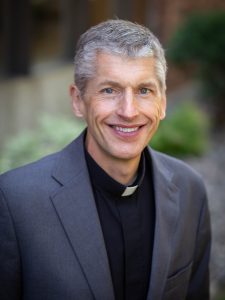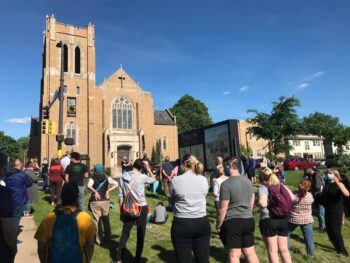 In early May, I attended a conference that was simultaneously shocking, challenging, and inspiring. It was called “Neighborhood Economics” and was hosted at a variety of sites in and around Indianapolis. The purpose of the conference was to explore ways that churches, nonprofits, and foundations could use their assets for greater impact in their local communities.
In early May, I attended a conference that was simultaneously shocking, challenging, and inspiring. It was called “Neighborhood Economics” and was hosted at a variety of sites in and around Indianapolis. The purpose of the conference was to explore ways that churches, nonprofits, and foundations could use their assets for greater impact in their local communities.
The shock was the realization of an impending tsunami of church closures facing American Christianity. Pre-pandemic estimates were that churches were closing at a rate of 75-100 a week, or 3,750-5,000 per year. Now with COVID and the continuation of previous trends, it is anticipated that up to 100,000 churches may close in the next three-to-five years.
“Pre-pandemic estimates were that churches were closing at a rate of 75-100 a week.”
The challenge, of course, is how to be faithful, responsible, compassionate stewards of the church assets that are involved with the closures of so many houses of worship.
The inspiration is that there are several committed, courageous organizations and individuals around the country that are working on ways to assist churches to meet this challenge
ABOUT 130 PARTICIPANTS were grouped into ten cohorts with focus areas that included “Aligning Endowments with Mission,” “Bridging the Racial Wealth Gap,” and “Faith on Main Street.” My cohort was called “Church Assets in Transition: Shifting imagination and practice from property management to community development.”
The opportunity to attend this conference was timely: On a white board in my office is a growing list of congregations that are actively considering a variety of transitional options with their buildings and/or properties. Some of those facing transitions are urgent, either because of financial challenges in the congregation or facility realities that are staring them in the face (i.e., deferred maintenance, emergency repairs, or other overdue upgrades to the structure or utilities).

Calvary Lutheran Church, Minneapolis, has voted to sell its building to a nonprofit partner which will turn the space into low-income housing. As part of a creative agreement, members will continue to worship in the current sanctuary space as it is developed as communal space for the new housing units.
Other congregations are trying to anticipate future facility needs as they come out of COVID and as they see other institutions and businesses in their community adapting to economic and cultural changes. Still others may have been approached by a developer with an idea to partner with them on a building project, or they have received an offer to buy their property outright.
“How can a congregation engage in a faithful, deliberate process of discernment about the future of its assets?”
Currently there are 15 congregations on my white board list – that’s over 10% of our synod. And these are only the ones I’m aware of; I would expect there are a handful of others that I’ve not heard about.
To be clear, I did not make this list because the synod controls congregational properties. It does not – congregations own and manage their own real estate and financial assets. However, the synod is in a position to provide guidance, resources, and connections that may be helpful to congregations.
How can a congregation engage in a faithful, deliberate process of discernment about the future of its assets? And at what point should that process take place?
IF YOU HAVE EVER asked yourself these questions, or if you’re asking them now based on what you’ve read in this blog so far, please contact me! I would love to learn more about your congregation’s situation and see if we can assist you in any way.
As a primer, I want to share a few resources that may be helpful to review on your own. The first is from an organization called Rooted Good, which says of itself, “We launched Rooted Good so faith-based organizations can align money and mission, reclaim their relevance in a changing world, and be the Church the world needs today.” It has produced an outstanding guidebook called “How to Develop Well: A Guide to Help Churches Work with a Property Developer.” I have two hardcopies of this guidebook, and hope to get electronic access to it soon. If you are interested in seeing it, I would love to share it with you!
A second guidebook is from a long-standing organization that some of your congregations may have worked with in the past, Partners for Sacred Places. The guide is called “Transitioning Older and Historic Sacred Places: Community-Minded Approaches for Congregations and Judicatories.” It is available online by clicking on the title above, then registering to receive it electronically.
“The shock was the realization of an impending tsunami of church closures facing American Christianity.”
A third resource that is ripe for “poking around” is the Ormond Center at Duke Divinity School. Its mission is “to foster the imagination, will, and ability of congregations and communities to be agents of thriving. We do this by equipping practitioners with the mindsets, skillsets, toolsets, and soulsets they need to serve their field, place, and neighbors.”
Each of these resources honors the importance of history, tradition, sense of place, and community context. Each discusses how a new mix of ownership structures, property uses, and partnerships might best serve the needs of churches as they move into the future.
Lastly, our synod is blessed with local consultants, architects, and developers who are also responding to the property needs of churches. I can put you in touch with these resources if you would find that helpful.
If nothing else, I hope you will at least begin to reimagine your building not as a burden to be cared for, but an asset that may have new uses for God’s mission in the world.
